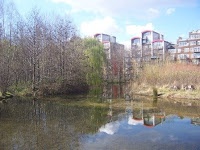
The first 'Millennium Community' inspired by Howard's garden cities the development of Grenwich Peninsula is supposed to bring urban development into the 21st century. A former industrial site cut off from the rest of London the essential to its success as Chris Choa suggested in his lecture on high density cities is a good mass transit system. The Jubilee Line reconnects the peninsula with the rest of London and the key transportation hub that is Waterloo.

Three large green spaces form the majority of the public space in the area and though the development is not yet finished you could see people beginning to use these spaces as the designers had intended. Almost as though you were walking around presentation images. However I found that the smaller spaces in between buildings which I believe are perhaps the most essential in terms of experience and the quality of the outdoor environment were inaccessible.
 I believe that fences, barriers items that are supposed to protect an area result in the opposite effect. Barriers can not stop the determined getting into a space where they want to go, instead they only serve to hinder and discourage those who we wish to use the space. If these Millennium Communities are precedent for future urban design I worry about their understanding and use of small urban spaces.
I believe that fences, barriers items that are supposed to protect an area result in the opposite effect. Barriers can not stop the determined getting into a space where they want to go, instead they only serve to hinder and discourage those who we wish to use the space. If these Millennium Communities are precedent for future urban design I worry about their understanding and use of small urban spaces. 





